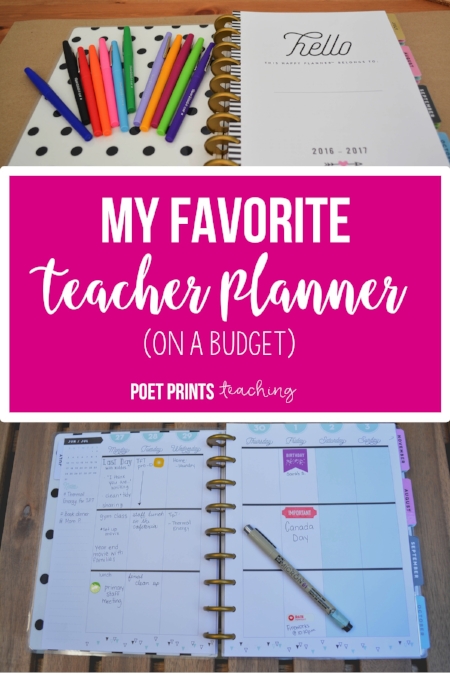Teacher planners are all the rage these days. If you have been anywhere in the blogosphere, or on Instagram, or FaceBook... you have seen teachers raving about their favourite planners. One of the most popular brands is the Erin Condren teacher planner. It's beautiful... but at over 100$ (including tax and shipping) to Canada, I just haven't been able to justify the purchase.
Enter... Happy Planner. I got mine at Michaels for 39$, and then used a coupon to get another 40% off the price. Yay, #MichaelsTeacher! You can also find them on Amazon for $29.

I love the idea of keeping my life organized on paper. Sure, there are some things I like to track electronically, but there is something so cathartic about writing everything down and seeing each day/week/month organized. It's part journalling, part organizing, all fun.
And who doesn't like stickers?! I thought I would review how the Happy Planner (Life Edition) stacks up as a teaching planner.
Happy Planner - The Pros
1. It's adorable!

Stylistically the planner is an absolute win. There are quite a few cute covers and styles to choose from, so you won't necessarily have the same planner as every teacher in the building.
2. Accessories Galore.

Just like other mega-planners, this one has so many things you can add on to make it your own. Stickers, washi-tape, extra pockets (for those staff-meeting hand outs you don't want to loose), more dividers. Each pop in easily to the plastic rings.
3. Customizable
The happy planner is a non-standard 9-hole planner, so every day paper can't be added into it. However, at Michael's they carry the Happy Planner Hole Punch. How easy would it be to add in extra pages to make the planner exactly what you want it to be. (Hint, hint.. I will be adding in student class checklists, phone numbers, and a to-do list... but it'll be a breeze to print, punch, and go!) So many sellers on TpT offer Happy Planner compatable products for teachers so making this your own is a breeze!
4. Bright, Clean, Design

The Happy Planner isn't cluttered, so it's easy to write lesson plans in each of the three daily boxes. I know that some teachers prefer the day to be broken up further, or have room for standards checklists... but this is perfect for my style. Currently, I've used the boxes for Before Recess, Between Recess and Lunch, and After Lunch. Sure, I still do detailed lesson plans, but this helps me to get a quick grasp of what my week will look like. (See below!) Plus, the planner itself isn't too cluttered with doodles and designs, so there's plenty of space to write.
5. 18 months
The planner comes with 18 months of pages so there's plenty of room to plan in advance. I love that I'm not left scribbling leftover ideas on the back page.
Happy Planner - The Cons
1. It's not specifically a teacher-planner
If you are looking for the absolute perfect solution that can allow you to toss out your lesson planning book... this may not be it. For me, it will suffice. I am okay with the vague nature of the 3-block days... but this may not be your cup of tea. Because it is not a teacher planner, it also doesn't have the teacher documents you may be looking for: quick student checklists, conference forms, or any curriculum planning documents.
That being said... you could add them in. With the Paper Punch, your own add-ins are virtually endless. I'm hoping to add my own personal class list in, so I'm never without a marking sheet or contact information.
I have now used it for an entire year and I am totally happy. I love that it fits in my purse and can travel from home to school. I write in my daily lessons and my after-school schedule and I am so much more organized!

2. Accessories Galore
I know what you're thinking... wasn't this a "pro"? Well... yes. Quite a bit of what makes the Happy Planner incredibly useful is available as an "add on".
Want a pack of pocket dividers? They're available separately.
Like those cute stickers that show a birthday? They're a separate pack!
Need some to-do lists or a page for phone numbers? Only an extra $7
How about a shiny gold band to hold the planner together? Ditto!
The Happy Planner itself is just the base model. Sure, you can customize it to become the teacher planner of your dreams ... but not without shelling out a lot more money!
My Suggestions:

I love my happy planner. I bought the base model, plus the Michaels brand stickers. (Sorry Create 365 brand people!). They aren't the official stickers... and they work great! Just as sticky! I'd love to get the 'official' Happy Planner inserts, but I think I will just make my own. Maybe the craft of making some extra pages will even be fun!
How about you? Do you use a teacher planner? Do you have a favourite? I'd love to hear all about it in the comments below.






























































